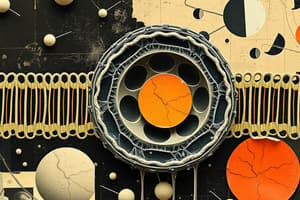Podcast
Questions and Answers
Which of the following is NOT a function of the cell membrane?
Which of the following is NOT a function of the cell membrane?
The cell membrane does not play a role in facilitating transport of substances.
The cell membrane does not play a role in facilitating transport of substances.
False
What is one key role of the cell membrane in cell-cell communication?
What is one key role of the cell membrane in cell-cell communication?
It allows cells to send and receive signals through receptors.
The cell membrane is fundamental for __________ between cells.
The cell membrane is fundamental for __________ between cells.
Signup and view all the answers
Match the functions with their descriptions:
Match the functions with their descriptions:
Signup and view all the answers
What components make up the cell coat or glycocalyx?
What components make up the cell coat or glycocalyx?
Signup and view all the answers
The cell coat or glycocalyx is exclusively made of glycolipids.
The cell coat or glycocalyx is exclusively made of glycolipids.
Signup and view all the answers
What is the primary function of glycocalyx in cells?
What is the primary function of glycocalyx in cells?
Signup and view all the answers
The cell coat or glycocalyx consists of both __________ and __________.
The cell coat or glycocalyx consists of both __________ and __________.
Signup and view all the answers
Match the components of the glycocalyx with their descriptions:
Match the components of the glycocalyx with their descriptions:
Signup and view all the answers
Study Notes
Cell Membrane Structure and Function
- The cell membrane is primarily composed of proteins and lipids.
- The basic structure of the cell membrane is a phospholipid bilayer.
- Phospholipid molecules in the cell membrane are arranged in a bilayer.
- Hydrophilic heads of phospholipids are oriented towards the interior and exterior of the membrane.
- Hydrophobic tails of phospholipids are oriented towards the interior of the membrane.
- The fuzzy appearance of the cell membrane observed under an electron microscope is due to glycoproteins.
- Functions of the cell membrane include facilitating transport of substances, providing structural support, and participating in cell-cell communication.
Membrane Transport Processes
- Endocytosis is the process of transporting large molecules or particles into the cell.
- Exocytosis is the process of transporting substances out of the cell.
- Pinocytosis is the process of taking in fluid particles by the cell membrane.
- Phagocytosis is the process of taking in solid particles by the cell membrane.
- Receptor-mediated endocytosis is the process of transporting specific molecules into the cell.
Cell Membrane Components and Their Functions
- Transmembrane proteins act as channels for the passage of ions and water-soluble substances.
- Transmembrane proteins that use energy to actively transport substances across the cell membrane are called pumps.
- Transmembrane proteins that bind to specific molecules and trigger a response within the cell are called receptors.
- The cell coat or glycocalyx contains glycolipids and glycoproteins.
- Functions of the glycocalyx include cell-cell recognition, adhesion, and protecting the cell from injury.
- Defects in cell coat enzymes can lead to various conditions such as malabsorption syndrome, dwarfism, type II diabetes, or lactose intolerance.
Additional Information
- The cell membrane is essential for cell signaling, metabolism, and transport.
- The cell membrane is involved in endocytosis, exocytosis, and membrane trafficking.
- The cell membrane is composed of 50% lipids and 50% proteins.
- The hydrophobic nature of the cell membrane is due to phospholipids.
- Cholesterol in the cell membrane affects fluidity.
Studying That Suits You
Use AI to generate personalized quizzes and flashcards to suit your learning preferences.
Related Documents
Description
Test your knowledge on the cell membrane's structure and functions with this quiz. Explore the roles of phospholipids, proteins, and various transport processes such as endocytosis and exocytosis. Ideal for biology students looking to reinforce their understanding of cell membranes.




